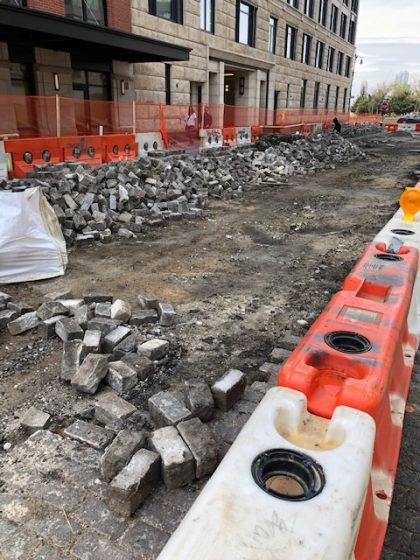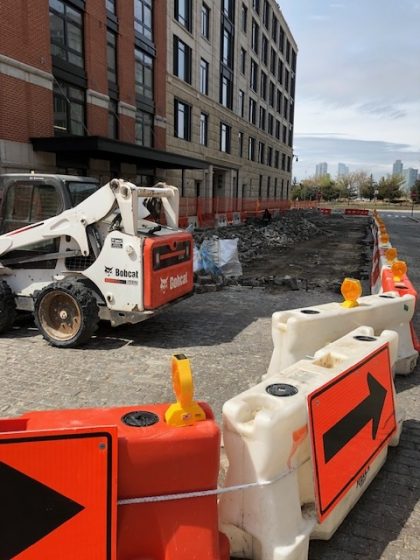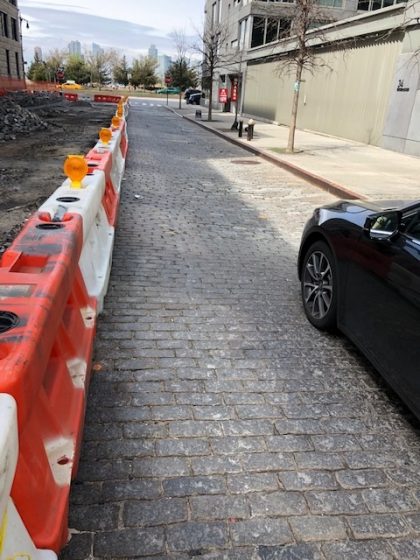Categories
Left column house ads
Seen & Heard: New cobblestones for Desbrosses
April 18, 2019 Construction, Kids, Parks, Restaurant/Bar News
M. sent these pics of the cobblestones on Desbrosses between Washington and the highway being relaid, and from what it looks like, they are doing the job right. This is on the north side of 70 Vestry. Anyone know whose work this is? Assuming not the city… UPDATE FROM JAMES: A private contractor has the permit to do this work from April 15 to May 3.
LAWNS ARE OPEN AT ROCKEFELLER
After their usual winter hiatus, the fences are now down at Battery Park City parks.
GREEN FOR AS FAR AS THE EYE CAN SEE! #BatteryParkCity‘s lawns are open for the season: https://t.co/BUe2o6312o #BPC #BPCCommunity #BPCGreen @CommunityBoard1 @TribecaTrib @tribecacitizen @yuhline @CM_MargaretChin @galeabrewer @BrianKavanaghNY @GPTA_BPC @FiDiKids @FiDiFamilies pic.twitter.com/3fZ2OY0flN
— BPCA (@bpca_ny) April 17, 2019
WHERE TO BRUNCH ON EASTER
The Downtown Alliance has a roundup of seven spots for Easter brunch, including the Tuck Room, Temple Court and Harry’s.
HUDSON EATS HAS CONCERTS FOR KIDS
The last few Saturday Morning Show music events for kids will take place this and next weekend at Brookfield’s food court, Hudson Eats. On April 20, there’s music with Sweetbeatz at 10 and Mario the Maker Magician at 11; April 27 is Shira & Friends at 10 and a performance by Sammie and Tudie at 11. For more info:
8 Comments
Comment:
Subscribe
Subscribe to the TC Newsletter

















I hope they redo Greenwich Street !
“While it has often been reported that Belgian blocks were imported to New York as ship ballast, we have not found primary evidence to confirm this practice.”
Above footnote and below text from: ‘Toward Accessible Historic Streetscapes; A Study of New York City’s Belgian Block Heritage’
Prepared for the Historic Districts Council
April 2017
“A Brief History: New York’s Belgian Block Heritage
“Over the past century and a half, the stones in New York City’s streets have gone by many names. In this report, we refer to the city’s typical, 19th-century granite paving stones as Belgian blocks. These mostly rectangular, tooled granite stones were used as paving materials in cities across America. With the term Belgian block, we distinguish these stones from an earlier paving material, cobblestones, which are untooled, naturally rounded stones that generally predated the use of tooled granite in city pavements. Cobblestones were typically used up to about 1860.
“Despite the name Belgian block, it remains unclear to what extent, and during what era, paving stones imported from Belgium may have provided the raw materials for New York City’s streets. It is known that the city’s early paving stones included a type of six inch-square traprock commonly called “Belgian” block, and said to have first been used in Belgium. This non-granitic, igneous stone block, reportedly sourced from the New Jersey Palisades, was introduced in 1852 and in general use after 1859. None of these paving stones are known to be in use today.
“The surviving stone we refer to as Belgian block began to be used in the 1870s. It was most likely sourced from quarries within the United States. By 1877, for example, New York contractors were said to have purchased large quarries in the Northeast for the purpose of providing granite paving blocks to New York City. In 1895, the Commissioner of Public Works reported that all of New York City’s granite paving blocks were obtained from quarries on the New England coast. Stones were notably sourced from Maine, including quarries on the island of Vinalhaven.
“The existing Belgian block stones in New York City streets today are presumably of this later type quarried in America. Nonetheless, we retain the term Belgian block due to its generally accepted use in referring to granite paving stones, as well as its evocation of the European character that pervaded the city’s early streetscapes and continues to contribute a distinctive sense of place today.”
I meant to reply to Jane below
Ditto for the need to redo Greenwich. I heard when we moved in that the cobblestone streets would all get redone as part of the building contractors’ construction agreements (since their trucks destroy the roads). Is there any truth to that?
I’ve heard that these cobblestones all around Tribeca served as ballast in 19th-century ships. Is that true, or apocryphal?
According to this NYT’s article it was ship ballast. You can also see in the picture why the new cobblestones failed – I suspect to save money the contractor used too much mortar and so when the heavy construction trucks drive over them they broke down the mortar and the cobblestones moved.
https://www.nytimes.com/2010/07/19/nyregion/19cobblestone.html?mtrref=www.google.com
See my reply above
Unless installed on a solid base of concrete (see stretches of Beach / N Moore / Franklin / Harrison between Hudson and Greenwich which are holding up well) they will warp in the next few years. Unfortunately it looks like packed soil in the photos above…